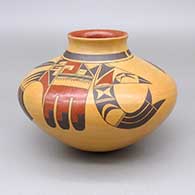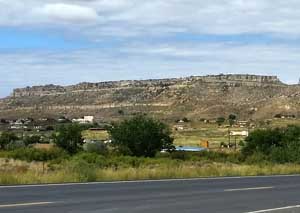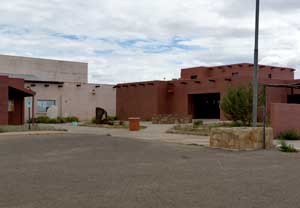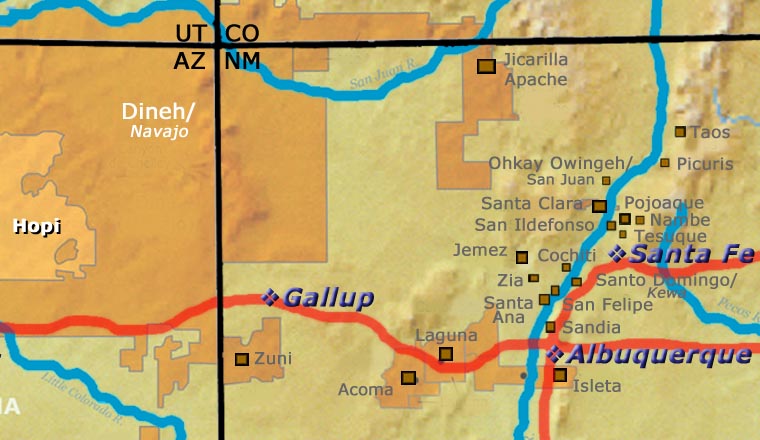
Loren Ami
1968-2020
Hopi
Loren Ami was born in March 1968 in Winslow, AZ, but most of his years growing up were spent in Santa Fe, NM, where his mother worked for the Indian Health Service. He was never exposed to Clay Mother until he took a class in ceramics at Santa Fe High School. His aptitude for making pottery was almost immediately apparent.
For his final year in high school, Loren and his mother moved back to Hopi. He was reunited with his grandmothers, Eleanor Ami and Carol Namoki, both excellent potters. Then he met Camille Quotskuyva and fell in love.
He was helping Camille with her pottery when her mother, Dextra Quotskuyva, saw his work and, taking him under her wing, encouraged him to do his own work. In the end, it was Dextra who taught him the most.
As Camille's companion, Loren's pottery was seen by everyone who came to Hopi to buy pottery from her (and she had a steady stream of customers arriving). His canteens with their crisp Sikyátki-Revival designs were very popular. In 1999 Loren went to the Santa Fe Indian Market and won a First Place ribbon for one. In 2000 he entered a painted jar in the juried competition at Santa Fe and won a Second Place ribbon.
Loren passed away in 2020.
100 West San Francisco Street, Santa Fe, New Mexico 87501
(505) 986-1234 - www.andreafisherpottery.com - All Rights Reserved

Hopi

Tewa Village and First Mesa
The Hopi people live in villages on or around three mesas in northeastern Arizona. Some of these villages have been continuously occupied since the 12th century. The Hopi are not so much a "people" as a collection of clans that came together in times of drought and other misfortune. The Hopi mesas have long been seen as sanctuaries. As a result, the landscape around First Mesa is littered with the remains of villages once founded by people belonging to similar clans but speaking many different languages.
As a result, the Hopi pottery tradition is also quite varied with roots traced as far away as vitrified ceramics found in the environs of Valdivia, Ecuador, and produced between 1200 and 1500 BCE. Archaeologists excavating in the abandoned pueblos around First Mesa also found sherds of pottery styles and painted designs found in the Rio Salado region and among the ancient Sinagua settlements in the Wupatki, Tuzigoot, Walnut Canyon and Homol'ovi areas (all abandoned between about 950 and 1250 CE).
The area around Jeddito was occupied by Towa-speaking people beginning in the late 1200s. The Jeddito area is where Jeddito yellow is found, the clay that made the pottery of Sikyátki so spectacular. Beginning in the 1200s, Keres-speaking people arriving from the east began to build what became Awat'ovi, on Antelope Mesa between Jeddito and First Mesa. Sikyátki itself was also built by people from the east beginning in the early 1300s. At first Sikyátki was inhabited solely by the Kokop (Firewood) clan, then the Coyote clan came and grew to become the largest single clan in the village. Why the village was destroyed is shadowed in myth but Jesse Walter Fewkes (the first archaeologist to excavate in the area) felt the village was destroyed before the first Spanish visitor arrived in 1540. Oral history has it that Sikyátki and its people were completely wiped out but the clans that inhabited that village have somehow continued to exist. Modern dating techniques have set the destruction of Sikyátki around 1625.

The Hopi Cultural Center
The ruins at Awat'ovi (on Antelope Mesa, east of Walpi and south of Keams Canyon) have yielded potsherds in styles and with designs that were also prominent in the prehistoric village now known as Pottery Mound (in central New Mexico). Among the potsherds found at Pottery Mound are plain and decorated Hopi products, white clay products from the Acoma-Zuni area and red clay products from north-central New Mexico. Pottery Mound was abandoned about 100 years before the Spanish arrived in New Mexico in 1540. Also similar to Pottery Mound, Awat'ovi had several kivas painted with layers of wall murals, each painted on top of the whitewashed last.
It has been reported that many of the residents of Awat'ovi were Keres-speaking people from the Four Corners area and were not as resistant as other Hopis were to the Christianizing practices of the Spanish Franciscan monks when they came into the Hopi lands around 1609. As Awat'ovi was the only pueblo in the Hopi region where a Christian mission was built, most archaeologists attribute that to the reason why residents of Walpi and Old Oraibi destroyed the village and killed nearly all its residents in the winter of 1700-1701. However, at the time of that destruction, Awat'ovi was the largest and most populous pueblo in the Hopi mesas. It was also around 1690 that the people of Walpi were relocating from their old pueblo at the foot of First Mesa to their new location atop the southernmost finger of First Mesa, a move made for defensive reasons. This was after the Pueblo Revolt of 1680 and everyone was expecting the hated Spanish to return, with more soldiers and priests.
Southern Tewa warriors and their families began arriving in the area in 1696 and were steered to take up residence at the foot of First Mesa, along the only route to the mesa top (in that location, the Tewas would be the first people to encounter incoming Spanish military - the people of Walpi felt they would make a good first line of defense should the Spanish attempt to reconquer them). The Tewas were also good at repulsing Ute, Paiute and Navajo raiders. After they won a decisive battle with Ute raiders they were allowed to build Tewa Village (also known as Hano) at the gap between the rocks on the trail up First Mesa. Some of the Tewa women were potters and in the ages-old way, they slowly shared what they knew with Hopi potters, and vice versa. That cross-pollination went on for years, and not just with pottery. Cross-cultural marriages happened, too, and today the people are known as Hopi, Hopi-Tewa and Tewa, depending on their ancestry. And while Tewa Village is completely surrounded by the Hopi Reservation, many of the residents are fluent in Tewa, Hopi and English. Some are fluent in Spanish and Navajo, too. There is a tribal injunction against any Hopi speaking Tewa: they may understand what is being spoken in Tewa but they are not allowed to speak Tewa themselves.
During those same troubled times Towa-speaking people migrated into Hopi and Navajo territory (primarily in the Jeddito Wash area) to escape the violence of the Spanish reconquest. They established familial ties that are still in place today (which may explain why Jeddito Wash is a Navajo Reservation island surrounded by the Hopi Reservation).
The village of Sichomovi was founded in the 1600s by members of the Wild Mustard Clan, Roadrunner Clan and others who'd come to the area from east of Santa Fe (Pecos Pueblo and the pueblos of the Galisteo Basin) via Zuni. They seem to have stopped at Zuni for a few years and assimilated somewhat. When they moved on to Hopi, there were quite a few Zunis among them, that's why the people of Walpi (and some from Zuni) refer to Sichomovi as a Zuni pueblo.
They arrived at Hopi around 1600 CE and became known as the Asa clan. They had traveled from the Abiquiu area through Santo Domingo, Acoma, Laguna and Zuni, picking up and dropping off people, technology and social practices along the way. Some settled at Awat'ovi while others continued to Coyote Spring (under the gap at First Mesa). They built a new pueblo where Hano now stands (it was known as Hano back then, too). A few years later drought and disease caused them to relocate again.
The quality, styles and designs of Sikyátki had lived on in Awat'ovi pottery, although the potters of Awat'ovi were also enamored of using a white slip on top of the Jeddito clay base. The potters of Awat'ovi also introduced some new designs (the "Awat'ovi star" being one) but after the village was destroyed, very little of their knowledge and practice passed on. Hopi ceramics entered a virtual Dark Age for almost 200 years.
By the mid-1800s the Hopi pottery tradition had been almost completely abandoned, its utilitarian purposes being taken over by cheap enamelware brought in by Anglo traders. Hopi pottery production sputtered along until the late 1800s when one woman, Nampeyo of Hano, almost single-handedly revived it. Nampeyo lived in Tewa Village by First Mesa and was inspired by potsherds found among the nearby ruins of Sikyátki. Today credit is given to Nampeyo for fully reviving the Sikyátki style. She was so good that Jesse Walter Fewkes, the first archaeologist to formally excavate Sikyátki, was concerned that her creations would shortly become confused with those made hundreds of years previously.
Sikyátki pottery shapes are very distinctive: flattened jars with wide shoulders; low, open bowls decorated inside; seed jars with small openings and flat tops; painting methods of splattering and stippling and very distinctive designs. The Sikyátki style originally evolved when migrant Keres and Towa-speaking potters got together with migrant Water Clan potters from the Hohokam areas of southern Arizona and northern Mexico and they began working with clays found in the Jeddito area. Over the years other clans came to the area and made their own contributions to what we now know as "Sikyátki Polychrome." Accoding to Jesse Walter Fewkes, that merging of styles, techniques and designs created some of the finest ceramics ever produced in prehistoric North America.
Today's Hopi pottery tends to be a white, yellow, orange or buff colored background decorated with designs in red and black mineral paints. Painted designs sometimes fill the entire space, often with an asymmetrical and symmetrical design. Most of the symbology painted on Hopi pottery is themed with "bird elements:" eagle tails, feathers, bird wings and migration patterns. Many Hopi, Hopi-Tewa and Tewa potters are members of the Corn Clan and their annual religious cycle revolves around the seasons of corn. The vast majority of today's Hopi pottery shapes and the designs painted on them are obvious descendants of the work of Sikyátki and Awat'ovi potters.
100 West San Francisco Street, Santa Fe, New Mexico 87501
(505) 986-1234 - www.andreafisherpottery.com - All Rights Reserved



